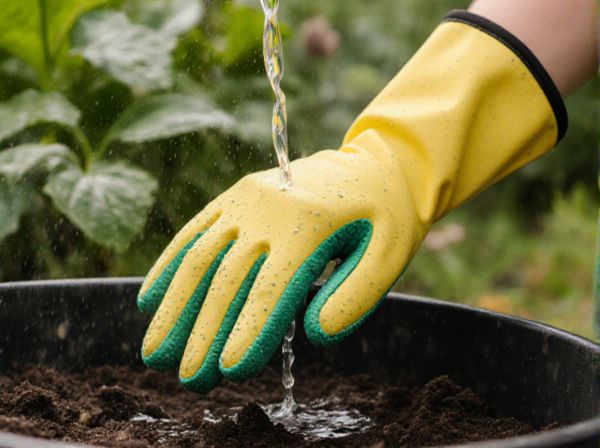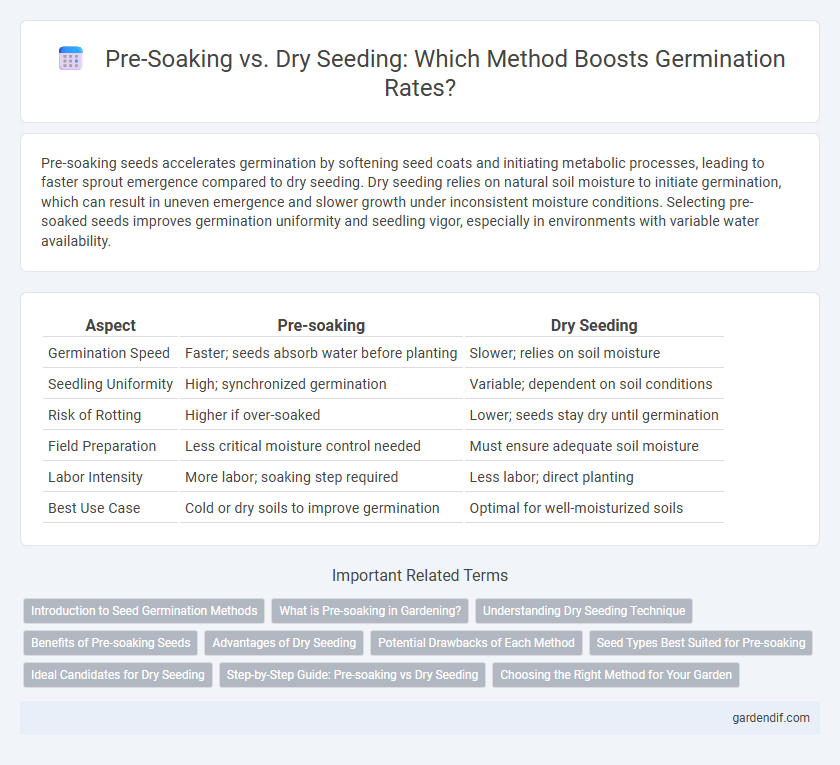
Pre-soaking vs Dry Seeding Illustration
Pre-soaking seeds accelerates germination by softening seed coats and initiating metabolic processes, leading to faster sprout emergence compared to dry seeding. Dry seeding relies on natural soil moisture to initiate germination, which can result in uneven emergence and slower growth under inconsistent moisture conditions. Selecting pre-soaked seeds improves germination uniformity and seedling vigor, especially in environments with variable water availability.
Table of Comparison
| Aspect | Pre-soaking | Dry Seeding |
|---|---|---|
| Germination Speed | Faster; seeds absorb water before planting | Slower; relies on soil moisture |
| Seedling Uniformity | High; synchronized germination | Variable; dependent on soil conditions |
| Risk of Rotting | Higher if over-soaked | Lower; seeds stay dry until germination |
| Field Preparation | Less critical moisture control needed | Must ensure adequate soil moisture |
| Labor Intensity | More labor; soaking step required | Less labor; direct planting |
| Best Use Case | Cold or dry soils to improve germination | Optimal for well-moisturized soils |
Introduction to Seed Germination Methods
Pre-soaking seeds involves hydrating them in water before planting to accelerate germination by softening the seed coat and activating metabolic processes. Dry seeding skips this hydration step, relying on soil moisture to initiate seed germination naturally, which can result in slower and less uniform emergence. Understanding these distinct methods is essential for optimizing seedling establishment based on environmental conditions and crop type.
What is Pre-soaking in Gardening?
Pre-soaking in gardening involves soaking seeds in water for a specific period before planting to accelerate germination and improve seedling vigor. This method enhances water absorption, softening the seed coat and activating enzymes necessary for sprouting. Pre-soaking is especially beneficial for hard-coated seeds and can significantly reduce germination time compared to dry seeding.
Understanding Dry Seeding Technique
Dry seeding involves planting untreated seeds directly into dry soil, allowing natural moisture to trigger germination, which enhances seedling establishment in arid conditions. This technique reduces pre-planting labor and minimizes seed handling risks compared to pre-soaking methods, making it suitable for large-scale agricultural operations. Dry seeding benefits from precise timing and soil temperature monitoring to maximize germination rates and improve crop yields.
Benefits of Pre-soaking Seeds
Pre-soaking seeds accelerates germination by ensuring uniform moisture absorption, which enhances seedling vigor and reduces the risk of uneven emergence. This method improves seed coat permeability, leading to faster enzyme activation and metabolic processes essential for growth. Compared to dry seeding, pre-soaking increases germination rates and promotes more consistent crop establishment, especially in arid or low-moisture environments.
Advantages of Dry Seeding
Dry seeding enhances early root development by establishing seed-to-soil contact under optimal moisture conditions, reducing the risk of seed rot and fungal infections common in pre-soaked seeds. This method decreases labor and water use, improving efficiency and sustainability in large-scale agriculture. Furthermore, dry seeding allows better timing flexibility, enabling sowing during optimal field conditions without the risk of seed damage associated with pre-soaking.
Potential Drawbacks of Each Method
Pre-soaking seeds enhances water absorption and speeds germination but increases the risk of fungal infections and seed rot if moisture management is poor. Dry seeding reduces initial handling and disease risk but may lead to uneven germination and slower sprout emergence due to delayed water uptake. Both methods require careful environmental control to optimize seedling vigor and uniformity.
Seed Types Best Suited for Pre-soaking
Pre-soaking seeds is especially effective for large, hard-coated seeds such as beans, peas, and cucumbers that benefit from moisture softening the seed coat to accelerate germination. Small or delicate seeds like lettuce or carrots generally perform better with dry seeding to avoid potential rot or mold issues. Seeds with naturally long dormancy periods, such as certain tree species, also respond well to pre-soaking to enhance water absorption and trigger quicker germination.
Ideal Candidates for Dry Seeding
Ideal candidates for dry seeding include crops such as wheat, barley, and rye that are tolerant to variable moisture conditions and can germinate effectively once soil moisture becomes available. Dry seeding is advantageous in regions with unpredictable rainfall or early-season planting schedules, as it allows seeds to be sown ahead of moisture presence without risking premature germination. This method is also suitable for hardy seed varieties with strong dormancy mechanisms that prevent germination until optimal environmental conditions are met.
Step-by-Step Guide: Pre-soaking vs Dry Seeding
Pre-soaking seeds involves immersing them in water for 12-24 hours to accelerate germination by softening seed coats and initiating metabolic processes. Dry seeding skips the soaking step, directly planting seeds into moist soil, relying on natural soil moisture to trigger germination. For optimal results, pre-soaking is recommended for hard-coated seeds, while dry seeding suits seeds with naturally thin coats and faster germination rates.
Choosing the Right Method for Your Garden
Pre-soaking seeds accelerates germination by hydrating the seed coat, promoting faster root emergence and improved uniformity. Dry seeding offers convenience and reduces labor but may result in slower, less consistent germination depending on soil moisture conditions. Selecting the right method hinges on crop type, soil temperature, and garden goals, with pre-soaking favored for quicker growth and dry seeding suited for larger-scale or drought-prone environments.
Pre-soaking vs Dry Seeding Infographic

 gardendif.com
gardendif.com